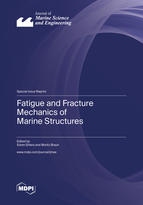Fatigue and Fracture Mechanics of Marine Structures
A special issue of Journal of Marine Science and Engineering (ISSN 2077-1312). This special issue belongs to the section "Ocean Engineering".
Deadline for manuscript submissions: closed (20 February 2023) | Viewed by 24821
Special Issue Editors
Interests: ship and offshore structural analysis under service and extreme conditions; Arctic engineering and ship design for extreme conditions
Interests: fatigue and fracture mechanics assessment of welded and non-welded structures and components; temperature and environmental effects on fatigue and fracture; effect of post-fabrication treatment on fatigue strength
Special Issue Information
Dear Colleagues,
Fatigue and fracture are important design criteria for marine structures subjected to static and cyclic loading. In particular, the ability to ensure structural integrity under all design conditions is of utmost importance due to the risk towards humans and the environment. Over the years, significant efforts have been allocated to the development of fatigue and fracture mechanics methods; however, for a number of reasons, discrepancies between predicted and actual strength remain.
The focus of this Special Issue is descriptions of the fatigue and fracture mechanics behaviour of marine structures. We seek studies aimed at novel methods (either analytical, empirical or numerical), as well as presentations of case studies or innovative test studies. Discussions of parameters which influence the fatigue and fracture behaviour of materials, welded joints, or structural components, such as loading conditions, scale effects, etc., will also be considered.
Finally, methods of improving the fatigue and fracture mechanics prediction of marine structures, either during design, fabrication or service may be addressed. Both original and review papers are welcome.
Prof. Dr. Sören Ehlers
Dr. Moritz Braun
Guest Editors
Manuscript Submission Information
Manuscripts should be submitted online at www.mdpi.com by registering and logging in to this website. Once you are registered, click here to go to the submission form. Manuscripts can be submitted until the deadline. All submissions that pass pre-check are peer-reviewed. Accepted papers will be published continuously in the journal (as soon as accepted) and will be listed together on the special issue website. Research articles, review articles as well as short communications are invited. For planned papers, a title and short abstract (about 100 words) can be sent to the Editorial Office for announcement on this website.
Submitted manuscripts should not have been published previously, nor be under consideration for publication elsewhere (except conference proceedings papers). All manuscripts are thoroughly refereed through a single-blind peer-review process. A guide for authors and other relevant information for submission of manuscripts is available on the Instructions for Authors page. Journal of Marine Science and Engineering is an international peer-reviewed open access monthly journal published by MDPI.
Please visit the Instructions for Authors page before submitting a manuscript. The Article Processing Charge (APC) for publication in this open access journal is 2600 CHF (Swiss Francs). Submitted papers should be well formatted and use good English. Authors may use MDPI's English editing service prior to publication or during author revisions.
Keywords
- fatigue and fracture of welded joints of thin and thick structures
- ultimate and fatigue limit state assessment of marine structures
- material relationships for finite element analysis of fracture onset and propagation
- numerical assessment for structural integrity assessment
- weld quality measurements for fatigue life assessment
- welding simulation







